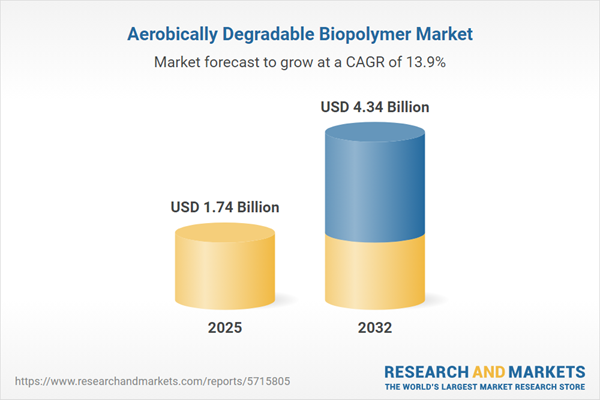Speak directly to the analyst to clarify any post sales queries you may have.
Organizations across industries are increasingly prioritizing sustainability and regulatory compliance in their supply networks. As a result, aerobically degradable biopolymers have emerged as a critical resource for executive teams seeking operational agility, reduced risk exposure, and long-term adaptability in global markets.
Market Snapshot: Global Aerobically Degradable Biopolymer Market Outlook
The global aerobically degradable biopolymer market demonstrates strong growth potential amid shifting regulatory frameworks and intensified efforts to minimize reliance on conventional plastics. As of 2024, market valuation stands at USD 1.53 billion, with expectations to reach USD 1.74 billion in 2025 and USD 4.34 billion by 2032, reflecting a strategic alignment with environmental, social, and governance (ESG) priorities. Stakeholder demand and innovation in advanced polymer technologies are spurring companies to transition toward sustainable materials, enabling compliance with dynamic standards and supporting resilience across core sectors. Investment in this market positions organizations to anticipate regulatory changes and respond effectively to increasing sustainability expectations.
Scope & Segmentation of the Aerobically Degradable Biopolymer Market
Senior decision-makers benefit from comprehensive segmentation analysis that highlights evolving industry requirements, supports targeted investments, and fosters regulatory adaptability across the aerobically degradable biopolymer market:
- Application Areas: Expansion is pronounced in agriculture, packaging, healthcare, and consumer goods, as each sector addresses distinct compliance demands and product performance benchmarks.
- Polymer Types: Key material categories include PBAT, PLA, PBS, and polyhydroxyalkanoates, chosen for their fit within both traditional and emerging production environments and their role in enabling innovative manufacturing approaches.
- End Uses: Common outlets range from bottles and films to straws, food trays, and diverse packaging solutions, where performance and regulatory requirements continue to evolve.
- Forms: Formats such as granules, films, fibers, and coatings facilitate process flexibility and broaden access to sustainable solutions across various workflows.
- Production Processes: Adoption of both chemical synthesis and fermentation techniques enhances supply strategies and creates opportunities for cost reduction and operational optimization.
- Regional Coverage: The Americas, Europe, Middle East, Africa, and Asia-Pacific regions each play pivotal roles in regulatory development, localizing supply chains, and influencing effective market entry strategies.
- Key Players: Industry direction is shaped by organizations such as NatureWorks LLC, TotalEnergies Corbion, BASF SE, Danimer Scientific, Mitsubishi Chemical Corporation, Evonik Industries, CJ CheilJedang, China Petroleum & Chemical, Zhejiang Hisun Biomaterials, and Kaneka Corporation, all of whom facilitate technology transfer and market adoption.
Key Takeaways for Executive Strategy
- Flexible supply chains and adaptive product designs equip organizations to address evolving compliance issues in regulated industries and maintain operational resilience.
- Close collaboration between suppliers and R&D drives the advancement of sustainable material technologies while supporting long-term innovation initiatives.
- Establishing full traceability within biopolymer supply networks enhances transparency and supports regulatory audits across international operations.
- Tailoring strategies to regional requirements enables organizations to minimize compliance risk and swiftly access growth opportunities as global policies shift.
- Modular, cross-regional sourcing and production frameworks allow efficient resource reallocation and ensure continuity against supply chain volatility.
Tariff Impact on Supply Chains and Trade Dynamics
Anticipated adjustments to global tariff structures in 2025 are motivating leadership teams to reassess supplier portfolios and procurement strategies. Strengthening and diversifying sourcing networks supports stability against unpredictable trade conditions and mitigates the effects of policy changes. Evaluating bio-based manufacturing incentives and maintaining wide supplier access helps organizations preserve business continuity and stay competitive as the international regulatory climate evolves.
Methodology & Data Sources
This analysis integrates insights from sustainability authorities, supply chain leaders, and trade policy experts. Findings are grounded in peer-reviewed research, proprietary patent intelligence, and scenario-driven modeling to ensure recommendations reflect the demands of a rapidly changing compliance environment.
Why This Report Matters
- Provides actionable intelligence on market trends and regulatory developments for executives developing sustainability and compliance strategies.
- Delivers localized procurement guidance to optimize supply chain design and adapt to evolving global trade regulations.
- Supports competitive benchmarking and informed decision-making for integrating new biopolymer technologies and monitoring adoption trends.
Conclusion
Strategic investment in aerobically degradable biopolymers advances objectives related to sustainable supply chains and compliance leadership. This report equips senior decision-makers with the insights required to navigate increasing market complexity and operationalize effective growth strategies.
Additional Product Information:
- Purchase of this report includes 1 year online access with quarterly updates.
- This report can be updated on request. Please contact our Customer Experience team using the Ask a Question widget on our website.
Table of Contents
3. Executive Summary
4. Market Overview
7. Cumulative Impact of Artificial Intelligence 2025
Companies Mentioned
The companies profiled in this Aerobically Degradable Biopolymer market report include:- NatureWorks LLC
- TotalEnergies Corbion
- BASF SE
- Danimer Scientific, Inc.
- Mitsubishi Chemical Corporation
- Evonik Industries AG
- CJ CheilJedang Corporation
- China Petroleum & Chemical Corporation
- Zhejiang Hisun Biomaterials Co., Ltd.
- Kaneka Corporation
Table Information
| Report Attribute | Details |
|---|---|
| No. of Pages | 183 |
| Published | October 2025 |
| Forecast Period | 2025 - 2032 |
| Estimated Market Value ( USD | $ 1.74 Billion |
| Forecasted Market Value ( USD | $ 4.34 Billion |
| Compound Annual Growth Rate | 13.9% |
| Regions Covered | Global |
| No. of Companies Mentioned | 11 |









